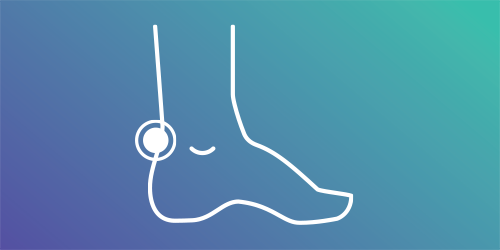
Experiencing Achilles Pain? Achilles pain refers to discomfort or pain that originates in the Achilles tendon or the area around it. The Achilles tendon is the largest and strongest tendon in our body. The fibrous band of tissue connects the two large calf muscles (the gastrocnemius and soleus) to the back of the heel bone (calcaneus). This tendon plays a crucial role in various activities such as walking, running, jumping – giving us the ability to rise up on to our toes.
Achilles Pain is usually a result of tendinitis caused by tight or fatigued calf muscles which transfer too much of the burden of walking or running to the Achilles tendon. If the tendon is placed under too much stress, then it will tighten and become over worked. The tendon becomes inflamed and over time can produce a covering of scar tissue which is less flexible than the tendon. If an inflamed achilles continues to be stressed, it can tear or rupture.
Causes of Achilles Pain:
- Not stretching the calves properly and repeated or excessive hill running and speed work, both of which stress the achilles more than other types of running, can bring on achilles tendinitis.
- Running in shoes that are too stiff can overload the achilles, while shoes that are too flexible allow the achilles tendon to twist and in some cases can contribute to achilles pain.
- People who over-pronate (their feet roll too far inward on impact) are most susceptible to achilles tendinitis.
The pain can be a dull or sharp pain any where along the back of the tendon, but usually close to the heel. Often there is limited ankle flexibility with redness or heat over the painful area. A nodule of scar tissue can often be felt in the tendon. Sometimes you can hear a cracking sound (scar tissue rubbing against tendon) when the ankle moves.
To help prevent achilles tendinitis, stretching the calf muscles is important. Wearing the right footwear and orthotics to address any biomechanical abnormality is important to help the normalise the strain on the tendon. Rest is recommended until the achilles is pain free. Then ease back into any running or walking program. Avoid hill work, speed work and sand.
- Reduce activity to pain free activity only.
- Correct foot mechanics with orthotics to normalise strain on the tendon.
- Massage the Achilles with an anti-inflammatory cream daily.
- Strapping and inserting temporary heel lifts may be required to unload the Achilles tendon.
- Stretch both calf muscles and Achilles tendon at least twice a day. Do not stretch if it is painful.
- Remember to incorporate rest into your future training schedule.
If you are experiencing pain or have achilles concerns, it is best to visit our Podiatrist for a Lower Limb Musculoskeletal Assessment. This Assessment is a series of clinical tests to determine the underlying cause of the pain and discomfort you are experiencing. At the end of the assessment, our Podiatrist will give you a treatment plan which may include orthotics, supported by exercises and shoe recommendations.

